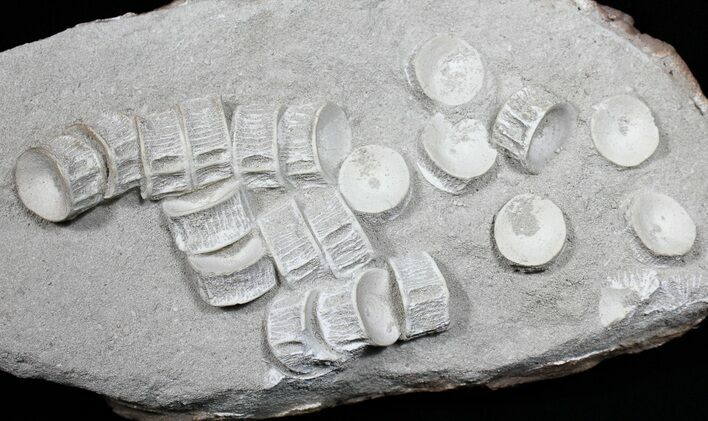This Specimen has been sold.
Otodus Shark Vertebrae Cluster - Great Preparation
This specimen was just acquired from one of our suppliers. We won't have it back in our warehouse to ship until Sept. 18th It is on sale until this date, so if you purchase it quickly you get a discount :)
This is a really cool cluster of fossilized shark vertebra which would have come from the extinct, giant mackerel shark, Otodus obliquus. They are Paleocene/Eocene in age, approximately 54 million years old and comes from the phosphate deposits in the Oulad Abdoun Basin of Morocco.
While isolated vertebrae are relatively common, clusters like this representing disarticulated vertebrae columns are unusual finds. Vertebrae also don't preserved as well as the teeth of these sharks.
The entire matrix is 11.3x5" and there are 20 verts present with the largest being 1.1" wide. It has been nicely prepared so that the fossils stand out in nice relief against the rock. The matrix has been backed with an epoxy to stabilize it.
The fossils of Otodus indicate that it was a very large, predatory shark. Based on the size of the largest known teeth and vertebrae Otodus may have reached a maximum size of nearly 40 feet in length. Otodus likely preyed upon marine mammals, large bony fish, and other sharks. It was among the top predators of its time.
Scientists determined that Otodus evolved into the genus Carcharocles, given substantial fossil evidence in the form of transitional teeth. Some teeth have been excavated from the sediments of the Potomac River in Maryland, USA, Ypres clay in Belgium, and western Kazakhstan, which are morphologically very similar to Otodus teeth but with lightly serrated cusplets and a serrated cutting edge. These transitional fossils suggest a worldwide evolutionary event, and support the theory that Otodus eventually evolved into Otodus aksuaticus and thus initiated the Carcharocles lineage.
This is a really cool cluster of fossilized shark vertebra which would have come from the extinct, giant mackerel shark, Otodus obliquus. They are Paleocene/Eocene in age, approximately 54 million years old and comes from the phosphate deposits in the Oulad Abdoun Basin of Morocco.
While isolated vertebrae are relatively common, clusters like this representing disarticulated vertebrae columns are unusual finds. Vertebrae also don't preserved as well as the teeth of these sharks.
The entire matrix is 11.3x5" and there are 20 verts present with the largest being 1.1" wide. It has been nicely prepared so that the fossils stand out in nice relief against the rock. The matrix has been backed with an epoxy to stabilize it.
The fossils of Otodus indicate that it was a very large, predatory shark. Based on the size of the largest known teeth and vertebrae Otodus may have reached a maximum size of nearly 40 feet in length. Otodus likely preyed upon marine mammals, large bony fish, and other sharks. It was among the top predators of its time.
Scientists determined that Otodus evolved into the genus Carcharocles, given substantial fossil evidence in the form of transitional teeth. Some teeth have been excavated from the sediments of the Potomac River in Maryland, USA, Ypres clay in Belgium, and western Kazakhstan, which are morphologically very similar to Otodus teeth but with lightly serrated cusplets and a serrated cutting edge. These transitional fossils suggest a worldwide evolutionary event, and support the theory that Otodus eventually evolved into Otodus aksuaticus and thus initiated the Carcharocles lineage.
SPECIES
Otodus obliquus
AGE
LOCATION
Oulad Abdoun Basin, Morocco
FORMATION
Phosphate Deposits
SIZE
Matrix 11.3x5", Largest Vert 1.4"
CATEGORY
SUB CATEGORY
ITEM
#31381
We guarantee the authenticity of all of our specimens.
 Reviews
Reviews













